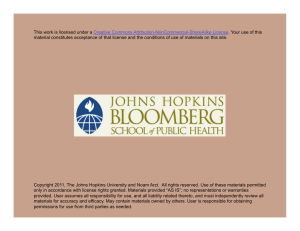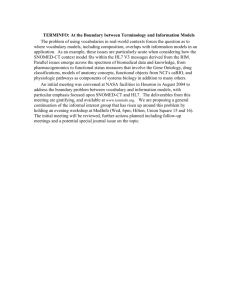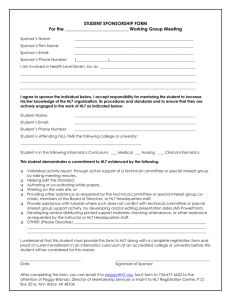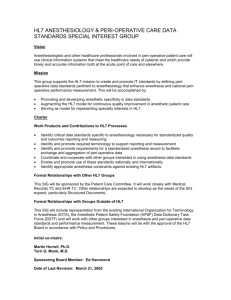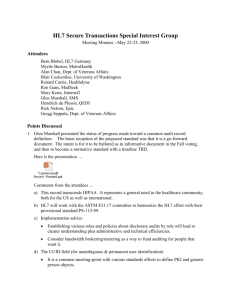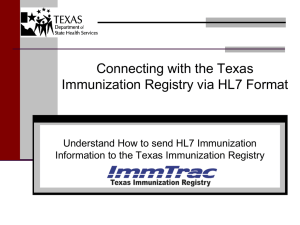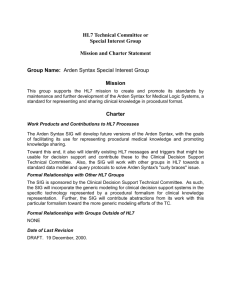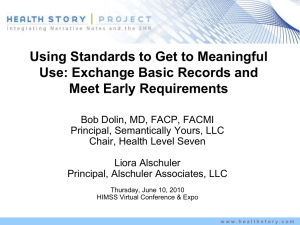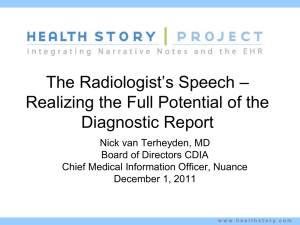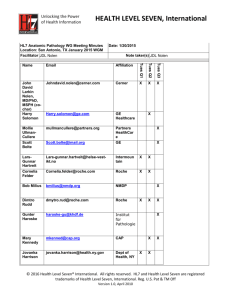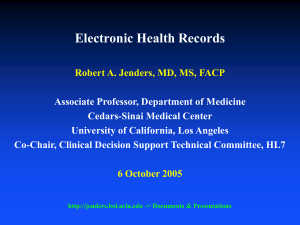ePrescribin in Sacyl using HL7 V3
advertisement
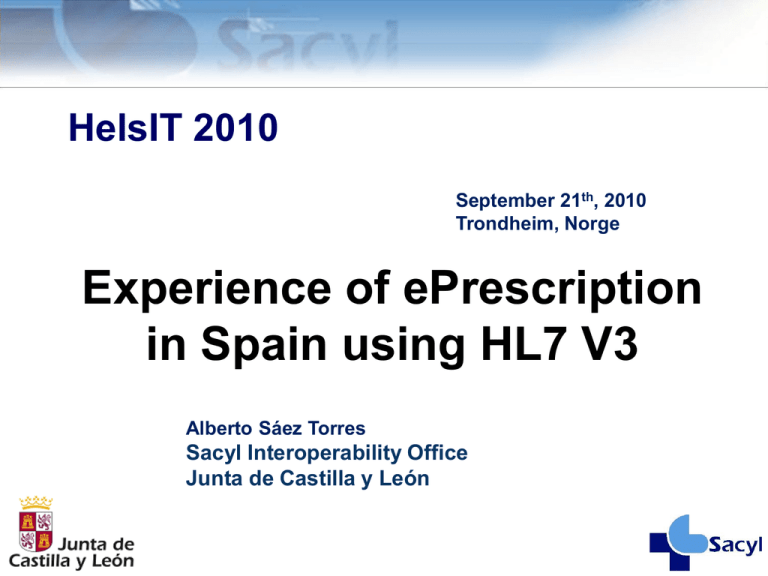
HelsIT 2010 September 21th, 2010 Trondheim, Norge Experience of ePrescription in Spain using HL7 V3 Alberto Sáez Torres Sacyl Interoperability Office Junta de Castilla y León About Me.. Alberto Sáez • Working on eHealth since 2002. • Working with specific eHealth standards, since 2004: − Certified HL7 V2.5 Chapter 2 Control Specialist (2005). − Certified HL7 CDA Specialist (2008). − Member of HL7 Spain Education WG for 4 years. • 2007- SACYL Interoperability Office – project leader. Overview of Spanish Public Health System Architecture of EHR in Sacyl Solution adopted for ePrescription Conclusions and project's evolution 4 3 1 2 AGENDA Spanish Public Health System • • • By 2002 public Health management had been transferred to each one of the 19 Autonomous Regions which make up the Spanish state. IT systems of each region have very little in common with the others (though they share the same roots). Interoperability is achieved through the services the SNS has developed: (Patient identification, referral, etc.) Castilla y León (Sacyl) • 20% of Spain territory • 2.5 million people (5%). • 14 hospital complexes. • 242 primary care centers. • >3000 auxiliary care centers (rural areas). Interoperability in Sacyl Intra-center communications Interoperability in Sacyl HL7 V3 Interoperability in Sacyl HL7 V3 Interoperability in Sacyl CDA R2 HL7 V3 Interoperability in Sacyl • • • • Massive adoption of V2 implementation guides in hospitals. Ad-hoc connections inside hospitals, has been removed. CDA R2 is a key element in the design of the EHR solution. All clinical documents in our repository are compliant. V3 messaging for inter-center communication and centralized services is in the beginning phase, including MPI, vocabulary and pharmacy products database. Published implementation guides V2.5 - Hospitals • ADT • Referral • Scheduling • Labs • Imaging • Blood Transfussion • Diets • Materials • Pharmacy • Vital Signs • Master Files V3 – Central Services • Enterprise Wide MPI • E-Prescription • CDA Starting conditions • • • • The EHR solution was not centralized. The EHR software of primary care and hospitals were different. Pharmacists didn’t have a connection with the Public Health system network. The National Health System (SNS) maintains: − A Master Patient Index. − A Medicine products Database (Nomenclator). Pilot Project Design • The objective was to collect the experience of users and technical results, to remove from the definitive project all the issues detected. • Used by a controlled number of doctors, centers and pharmacies. • Centered in chronically-ill patients. • It had to be deployed before 2010 in order to obtain sufficient results. • The design phase started June 2009. Pilot Project Design •Ensure a dispensation is suitable •Calculate the costs of products Pharmacists’s college node •Stores prescriptions and dispensations. •Calculate dates for valid dispensations Health Service Network Interface definition • HL7 V3 for all interfaces based in WS (normative version of 2008). • An implementation guide was defined by the Interoperability Office. This way, the pilot project could serve to evaluate the design cost and behavior of a V3 implementation. MPI Interface Interactions on Product Database Interactions Prescription/Repository Interactions Repository/Dispense Management Interactions Dispense Management /Pharmacists’ POS * Limited deployement Implementation details • Due to time frame (6 months from requirements to go-live), implementers decided not to use any HL7V3 specific messaging software. • Tools: − Traditional XML tools (Xpath, XMLBeans, templates). − Interface documentation XML-oriented. − XSD Schemas (plus locally-defined elements). Implementation details (II) • All messages should be interchanged between systems using an Interface Engine (IE) software. Project Results • The project began its production phase in mid December 2009. • It has been considered a success. − Including patients at the maximum rate. − More than 2.000.000 interactions. − No system failures related to the messaging infrastructure. F. Blanco (ABC) Conclusions • HL7 V3 Pharmacy and Medication universal domains models are valid, covering approx. 98% of our needs. Only a few specific requirements were solved using local extensions: − Support complex cost composition. − Additional parameters to queries. − Administrative-centered queries. Conclusions • The use of a Interface Engine (IE) as a communication node is a success. − One control point for all systems. − Allows solving application specific implementation problems until systems can be updated. − The IE must be “HL7 V3 ready”. Conclusions • From an implementer point of view, is it possible to face a V3 project without previous V3 knowledge ? It’s possible, though an expert group is needed to contribute guidelines in the design phase. But: − It implies a high cost in documenting interfaces for the implementer (IG). − There are no adequate tools to document interfaces. − It is difficult to use a model-driven architecture. − Messages seem too complex to most developers. And: − It has low impact on the implementers project’s budget. Project Evolution • Inclusion of new use cases. • No changes needed in the interface design. • V3 has been consolidated as a solution, and there are no doubts about its readiness. It’s been using in new projects: referrals, laboratory (intercenter), … • A working group has been established to work in RIM technologies to ensure new developments could use the full potential of HL7 V3 model. THANKS FOR YOUR ATTENTION Alberto Sáez Torres Oesía Networks SACYL Interoperability Office, Junta de Castilla y León asaez@oesia.com oficinaintegra.sscc@saludcastillayleon.es
